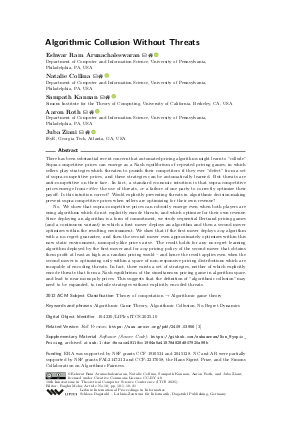Algorithmic Collusion Without Threats
Authors
Eshwar Ram Arunachaleswaran  ,
Natalie Collina
,
Natalie Collina  ,
Sampath Kannan
,
Sampath Kannan  ,
Aaron Roth
,
Aaron Roth  ,
Juba Ziani
,
Juba Ziani 
-
Part of:
Volume:
16th Innovations in Theoretical Computer Science Conference (ITCS 2025)
Part of: Series: Leibniz International Proceedings in Informatics (LIPIcs)
Part of: Conference: Innovations in Theoretical Computer Science Conference (ITCS) - License:
 Creative Commons Attribution 4.0 International license
Creative Commons Attribution 4.0 International license
- Publication Date: 2025-02-11
File

PDF
LIPIcs.ITCS.2025.10.pdf
- Filesize: 0.81 MB
- 21 pages
Document Identifiers
Related Versions
- Full Version https://www.arxiv.org/pdf/2409.03956
Subject Classification
ACM Subject Classification
- Theory of computation → Algorithmic game theory
Keywords
- Algorithmic Game Theory
- Algorithmic Collusion
- No-Regret Dynamics
Metrics
- Access Statistics
-
Total Accesses (updated on a weekly basis)
0PDF Downloads0Metadata Views
Abstract
There has been substantial recent concern that automated pricing algorithms might learn to "collude." Supra-competitive prices can emerge as a Nash equilibrium of repeated pricing games, in which sellers play strategies which threaten to punish their competitors if they ever "defect" from a set of supra-competitive prices, and these strategies can be automatically learned. But threats are anti-competitive on their face. In fact, a standard economic intuition is that supra-competitive prices emerge from either the use of threats, or a failure of one party to correctly optimize their payoff. Is this intuition correct? Would explicitly preventing threats in algorithmic decision-making prevent supra-competitive prices when sellers are optimizing for their own revenue? No. We show that supra-competitive prices can robustly emerge even when both players are using algorithms which do not explicitly encode threats, and which optimize for their own revenue. Since deploying an algorithm is a form of commitment, we study sequential Bertrand pricing games (and a continuous variant) in which a first mover deploys an algorithm and then a second mover optimizes within the resulting environment. We show that if the first mover deploys any algorithm with a no-regret guarantee, and then the second mover even approximately optimizes within this now static environment, monopoly-like prices arise. The result holds for any no-regret learning algorithm deployed by the first mover and for any pricing policy of the second mover that obtains them profit at least as high as a random pricing would - and hence the result applies even when the second mover is optimizing only within a space of non-responsive pricing distributions which are incapable of encoding threats. In fact, there exists a set of strategies, neither of which explicitly encode threats that form a Nash equilibrium of the simultaneous pricing game in algorithm space, and lead to near monopoly prices. This suggests that the definition of "algorithmic collusion" may need to be expanded, to include strategies without explicitly encoded threats.
Cite As Get BibTex
Eshwar Ram Arunachaleswaran, Natalie Collina, Sampath Kannan, Aaron Roth, and Juba Ziani. Algorithmic Collusion Without Threats. In 16th Innovations in Theoretical Computer Science Conference (ITCS 2025). Leibniz International Proceedings in Informatics (LIPIcs), Volume 325, pp. 10:1-10:21, Schloss Dagstuhl – Leibniz-Zentrum für Informatik (2025)
https://doi.org/10.4230/LIPIcs.ITCS.2025.10
BibTex
@InProceedings{arunachaleswaran_et_al:LIPIcs.ITCS.2025.10,
author = {Arunachaleswaran, Eshwar Ram and Collina, Natalie and Kannan, Sampath and Roth, Aaron and Ziani, Juba},
title = {{Algorithmic Collusion Without Threats}},
booktitle = {16th Innovations in Theoretical Computer Science Conference (ITCS 2025)},
pages = {10:1--10:21},
series = {Leibniz International Proceedings in Informatics (LIPIcs)},
ISBN = {978-3-95977-361-4},
ISSN = {1868-8969},
year = {2025},
volume = {325},
editor = {Meka, Raghu},
publisher = {Schloss Dagstuhl -- Leibniz-Zentrum f{\"u}r Informatik},
address = {Dagstuhl, Germany},
URL = {https://drops.dagstuhl.de/entities/document/10.4230/LIPIcs.ITCS.2025.10},
URN = {urn:nbn:de:0030-drops-226386},
doi = {10.4230/LIPIcs.ITCS.2025.10},
annote = {Keywords: Algorithmic Game Theory, Algorithmic Collusion, No-Regret Dynamics}
}
Author Details
- Department of Computer and Information Science, University of Pennsylvania, Philadelphia, PA, USA
- Department of Computer and Information Science, University of Pennsylvania, Philadelphia, PA, USA
- Simons Institute for the Theory of Computing, University of California, Berkeley, CA, USA
- Department of Computer and Information Science, University of Pennsylvania, Philadelphia, PA, USA
Funding
ERA was supported by NSF grants CCF 1910534 and 2045128. NC and AR were partially supported by NSF grants FAI-2147212 and CCF-2217058, the Hans Sigrist Prize, and the Simons Collaboration on Algorithmic Fairness.
Acknowledgements
We thank Rakesh Vohra and Deke Hill for valuable discussions on the subject of algorithmic collusion. SK was on leave from the University of Pennsylvania and serving as the Associate Director of the Simons Institute for the Theory of Computing at the time of writing of this paper. Finally, we would like to thank the ITCS reviewers for their helpful comments and feedback.
Supplementary Materials
-
Software (Source Code)
https://github.com/eshwarram/Non_Myopic_Pricing
browse
 archived version
archived version
References
- Ibrahim Abada and Xavier Lambin. Artificial intelligence: Can seemingly collusive outcomes be avoided? Energy Engineering (Energy) eJournal, 2020. URL: https://api.semanticscholar.org/CorpusID:219341239.
- Ibrahim Abada, Xavier Lambin, and Nikolay Tchakarov. Collusion by mistake: Does algorithmic sophistication drive supra-competitive profits? European Journal of Operational Research, 318(3):927-953, 2024. URL: https://doi.org/10.1016/j.ejor.2024.06.006.
- Eshwar Ram Arunachaleswaran, Natalie Collina, Sampath Kannan, Aaron Roth, and Juba Ziani. Algorithmic collusion without threats, 2024. URL: https://doi.org/10.48550/arXiv.2409.03956.
- Stephanie Assad, Robert Clark, Daniel Ershov, and Lei Xu. Algorithmic pricing and competition: Empirical evidence from the german retail gasoline market. Journal of Political Economy, 132(3):723-771, 2024. URL: https://doi.org/10.1086/726906.
- Martino Banchio and Giacomo Mantegazza. Artificial intelligence and spontaneous collusion, 2023. URL: https://arxiv.org/abs/2202.05946.
-
Jean-Pierre Benoit, Vijay Krishna, et al. Finitely repeated games, 1984.

-
Mark Braverman, Jieming Mao, Jon Schneider, and Matt Weinberg. Selling to a no-regret buyer. In Proceedings of the 2018 ACM Conference on Economics and Computation, pages 523-538, 2018.

- Emilio Calvano, Giacomo Calzolari, Vincenzo Denicolò, and Sergio Pastorello. Artificial intelligence, algorithmic pricing, and collusion. American Economic Review, 110(10):3267-3297, 2020. URL: https://doi.org/10.1257/aer.20190623.
-
Nicolo Cesa-Bianchi and Gábor Lugosi. Prediction, learning, and games. Cambridge university press, 2006.

- Sylvain Chassang and Juan Ortner. Regulating collusion. Annual Review of Economics, 15(Volume 15, 2023):177-204, 2023. URL: https://doi.org/10.1146/annurev-economics-051520-021936.
- Natalie Collina, Eshwar Ram Arunachaleswaran, and Michael Kearns. Efficient stackelberg strategies for finitely repeated games. In Proceedings of the 2023 International Conference on Autonomous Agents and Multiagent Systems, pages 643-651, 2023. URL: https://doi.org/10.5555/3545946.3598695.
- Vincent Conitzer and Tuomas Sandholm. Computing the optimal strategy to commit to. In Proceedings of the 7th ACM conference on Electronic commerce, pages 82-90, 2006. URL: https://doi.org/10.1145/1134707.1134717.
-
Yuan Deng, Jon Schneider, and Balasubramanian Sivan. Strategizing against no-regret learners. Advances in neural information processing systems, 32, 2019.

- Sara Fish, Yannai A. Gonczarowski, and Ran I. Shorrer. Algorithmic collusion by large language models, 2024. URL: https://doi.org/10.48550/arXiv.2404.00806.
- Karsten T Hansen, Kanishka Misra, and Mallesh M Pai. Frontiers: Algorithmic collusion: Supra-competitive prices via independent algorithms. Marketing Science, 40(1):1-12, 2021. URL: https://doi.org/10.1287/MKSC.2020.1276.
-
Joseph E Harrington. Developing competition law for collusion by autonomous artificial agents. Journal of Competition Law & Economics, 14(3):331-363, 2018.

- Jason D. Hartline, Sheng Long, and Chenhao Zhang. Regulation of algorithmic collusion. In Proceedings of the Symposium on Computer Science and Law, CSLAW '24, pages 98-108, New York, NY, USA, 2024. Association for Computing Machinery. URL: https://doi.org/10.1145/3614407.3643706.
- Timo Klein. Autonomous algorithmic collusion: Q-learning under sequential pricing. The RAND Journal of Economics, 52(3):538-558, 2021. URL: https://doi.org/10.1111/1756-2171.12383.
- Yoav Kolumbus and Noam Nisan. Auctions between regret-minimizing agents. In Proceedings of the ACM Web Conference 2022, WWW ’22, pages 100-111. ACM, April 2022. URL: https://doi.org/10.1145/3485447.3512055.
- Rohit Lamba and Sergey Zhuk. Pricing with algorithms, 2022. URL: https://arxiv.org/abs/2205.04661.
- Ryan Y. Lin, Siddhartha Ojha, Kevin Cai, and Maxwell F. Chen. Strategic collusion of llm agents: Market division in multi-commodity competitions, 2024. URL: https://doi.org/10.48550/arXiv.2410.00031.
- Michael L Littman and Peter Stone. A polynomial-time nash equilibrium algorithm for repeated games. In Proceedings of the 4th ACM Conference on Electronic Commerce, pages 48-54, 2003. URL: https://doi.org/10.1145/779928.779935.
- Uri Nadav and Georgios Piliouras. No regret learning in oligopolies: Cournot vs. bertrand. In International Symposium on Algorithmic Game Theory, pages 300-311. Springer, 2010. URL: https://doi.org/10.1007/978-3-642-16170-4_26.
-
Denis Nekipelov, Vasilis Syrgkanis, and Eva Tardos. Econometrics for learning agents. In Proceedings of the sixteenth acm conference on economics and computation, pages 1-18, 2015.

